Aerial triathlon photography offers a stunning perspective on this multi-sport event. You'll capture the patterns of mass swim starts, the intensity of cycling pelotons, and the beauty of running routes through diverse landscapes. To achieve these shots, you'll need a high-quality drone with 4K resolution, excellent stabilization, and long battery life. Scout locations in advance, considering terrain, lighting, and local regulations. Timing is essential – position yourself strategically to capture key moments like race starts and dramatic turns. By mastering drone techniques and understanding the unique challenges of triathlon coverage, you'll create compelling images that showcase both athletes and landscapes. Dive deeper to reveal the full potential of soaring triathlon views.
Capturing Triathlon's Three Disciplines
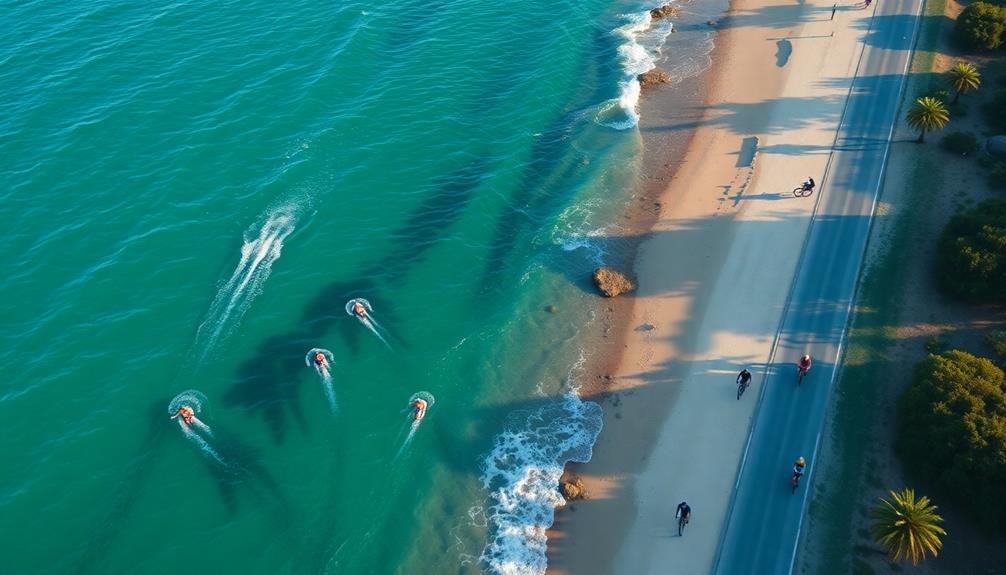
Triathlons present a unique challenge for photographers, demanding versatility and quick thinking to capture the essence of three distinct disciplines.
From above, you'll need to adapt your approach for each segment of the race. For swimming, focus on the patterns created by athletes in the water, using a bird's-eye view to showcase the chaos of mass starts or the streamlined formations of lead packs.
As the action shifts to cycling, you'll want to capture the speed and intensity of the bike leg. Look for sweeping curves in the road, pelotons working together, or lone riders pushing their limits.
Aerial shots can reveal the beautiful landscapes cyclists traverse and highlight the athletes' relationship with their surroundings.
Drone Equipment for Triathlon Photography
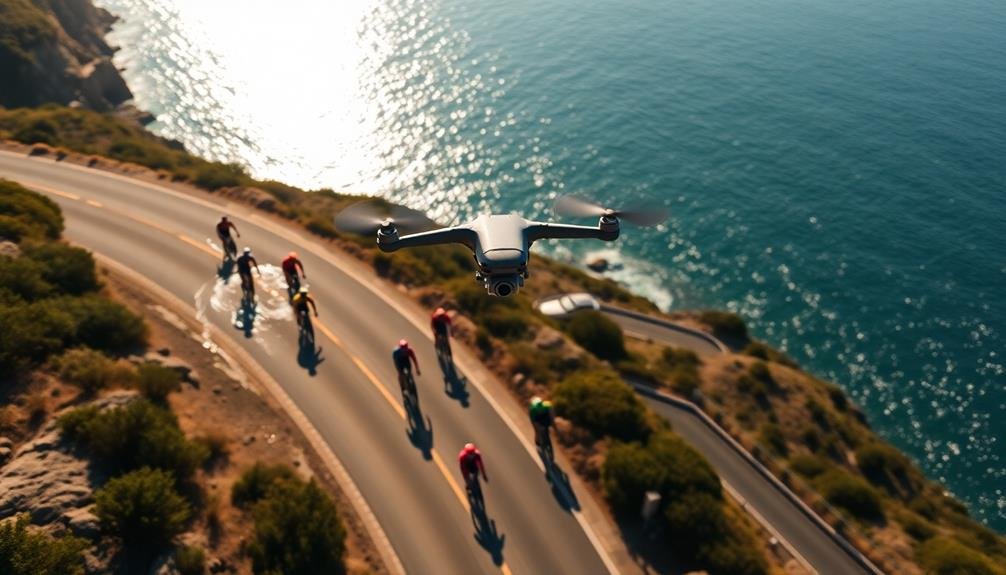
For capturing the dynamic nature of triathlons from above, you'll need the right drone equipment. Your drone should have a high-quality camera capable of shooting in 4K resolution, with excellent image stabilization to handle wind and movement.
Look for models with long battery life, as triathlons can last several hours. A drone with obstacle avoidance technology is essential for safely maneuvering through crowded event spaces.
When choosing your drone, consider these key features:
- GPS-enabled flight modes for smooth tracking shots
- Foldable design for easy transport to race locations
- Weather-resistant construction to handle various conditions
- Live streaming capabilities for real-time footage transmission
- Intelligent flight modes like orbit and follow-me for creative shots
Don't forget essential accessories like extra batteries, propeller guards, and a sturdy carrying case. A tablet or smartphone with a large screen will make it easier to see your drone's video feed and control settings.
Familiarize yourself with local drone regulations and obtain necessary permits before flying at triathlon events. With the right equipment and preparation, you'll be ready to capture stunning aerial footage that showcases the excitement and scale of triathlons.
Scouting Locations for Aerial Shots
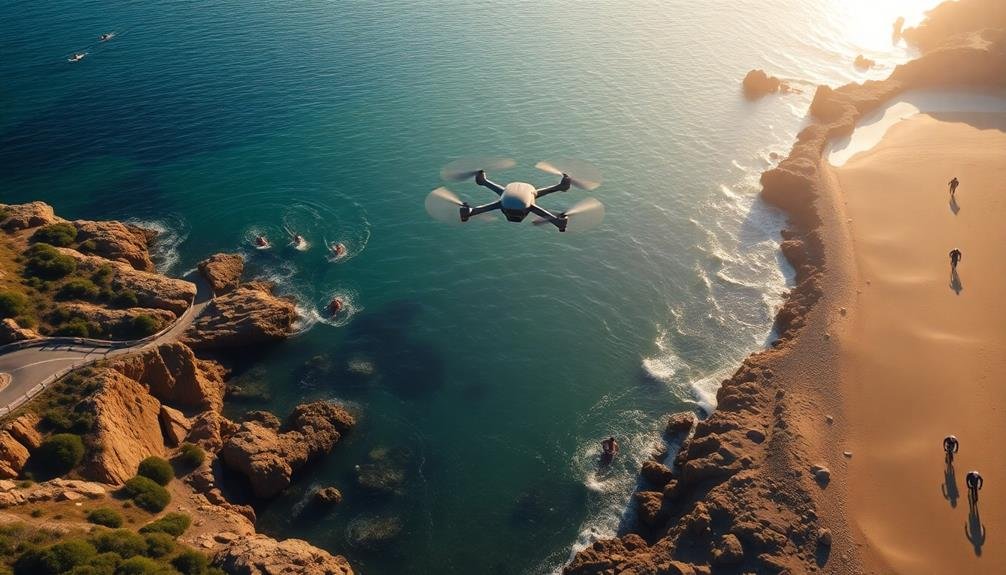
When scouting locations for aerial triathlon shots, you'll need to evaluate the terrain and elevation to determine ideal drone positions.
Familiarize yourself with local drone flight regulations to guarantee compliance and avoid restricted areas.
Don't forget to take into account lighting and weather conditions, as they'll greatly impact the quality of your aerial photographs.
Terrain and Elevation Analysis
Effective aerial photography for triathlons hinges on three key factors: terrain analysis, height scouting, and location selection. When you're planning your shoot, you'll need to carefully assess the landscape to identify prime vantage points.
Start by studying topographical maps and satellite imagery to get a sense of the area's features. As you analyze the terrain, look for:
- Natural elevations like hills or cliffs
- Man-made structures that offer height
- Open areas with unobstructed views
- Unique geographical features
- Safe and accessible landing zones
Pay close attention to how the terrain changes along the triathlon course. You'll want to capture the athletes as they change between swimming, cycling, and running stages.
Consider how different heights can provide varying perspectives on each segment of the race. Don't forget to factor in the sun's position throughout the day. The interplay of light and shadow can dramatically affect your shots, so you'll need to anticipate how the terrain's contours will influence lighting conditions.
Drone Flight Regulations
Numerous drone flight regulations govern aerial photography for triathlons, making location scouting an essential step in your planning process. You'll need to research local laws, airspace restrictions, and event-specific rules before taking flight. Always check for no-fly zones and obtain necessary permits.
When scouting locations, consider these key factors:
| Factor | Consideration |
|---|---|
| Elevation limits | Maximum allowed altitude for drone operations |
| Distance from crowd | Minimum required distance from spectators |
| Take-off areas | Designated spots for launching and landing |
| No-fly zones | Restricted areas near the course or facilities |
| Time restrictions | Permitted flying hours during the event |
Remember to respect privacy and safety concerns. You'll want to find vantage points that capture the essence of the triathlon without compromising athletes' or spectators' well-being. Look for open areas away from dense crowds and potential obstacles.
Don't forget to factor in your drone's capabilities, such as battery life and range. You'll need to plan your flight paths carefully to guarantee you capture key moments without running out of power or losing signal. By thoroughly scouting locations and understanding regulations, you'll set yourself up for stunning aerial triathlon photography.
Lighting and Weather Conditions
Lighting and weather conditions play an essential role in aerial triathlon photography. You'll need to evaluate the sun's position, cloud cover, and potential glare on water surfaces. Early morning or late afternoon often provide the best lighting, with warm, golden hues that can enhance your shots. Overcast days can offer soft, diffused light, ideal for capturing details without harsh shadows.
When scouting locations for aerial shots, keep these factors in mind:
- Wind speed and direction
- Sun angle and potential lens flare
- Water reflections and glare
- Cloud formations and patterns
- Potential obstacles or restricted areas
You'll want to check weather forecasts and plan your flights accordingly. Avoid flying in rain, heavy fog, or strong winds, as these conditions can compromise both your drone's performance and image quality.
Remember that different weather conditions can create unique atmospheric effects, such as dramatic cloud formations or misty landscapes, which can add depth and interest to your triathlon photos.
Always prioritize safety and adhere to local regulations when flying in various weather conditions. Be prepared to adjust your plans if conditions change unexpectedly, and have backup shooting strategies in place.
Timing and Positioning During Races
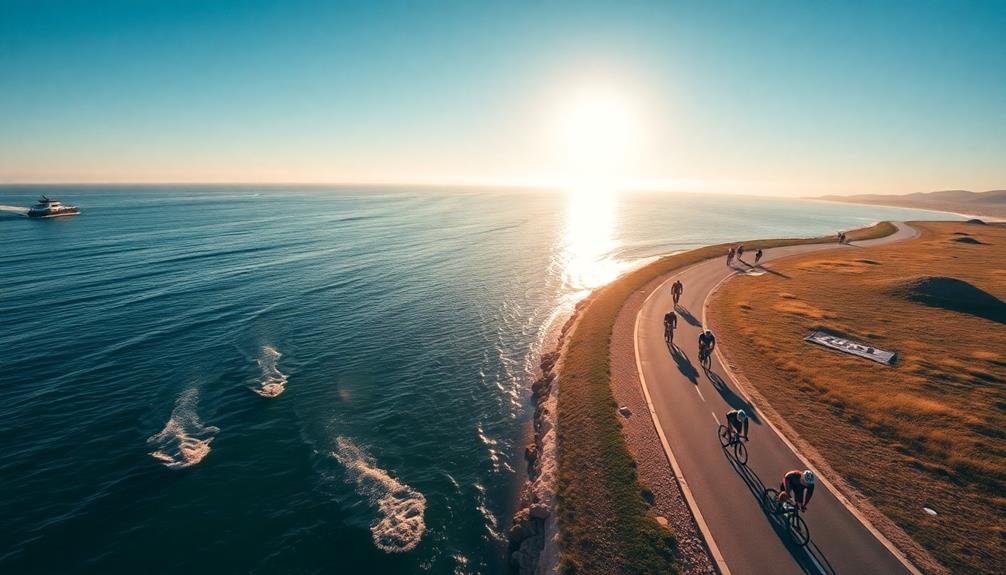
Anticipation is key when it comes to timing and positioning during triathlon races. You'll need to study the course map and predict where the most visually appealing shots will occur. Scout out vantage points that offer unobstructed views of the athletes, particularly during shifts between swim, bike, and run segments.
Position yourself at strategic locations like tight turns, steep hills, or iconic landmarks along the route. These spots often provide dramatic moments as athletes push their limits. Don't forget to capture the start and finish lines, where emotions run high and the energy is palpable.
Timing is essential. Be ready to shoot as the lead pack emerges from the water or rounds a corner. Use burst mode to capture rapid sequences of action. Pay attention to the race clock and estimated completion times to guarantee you're in the right place for key moments.
Consider using a drone for aerial shots, but be aware of regulations and safety guidelines. Drones can provide unique perspectives of the race, showcasing the scale and beauty of the event.
However, always prioritize the safety of athletes and spectators when operating aerial equipment.
Showcasing the Landscape's Beauty
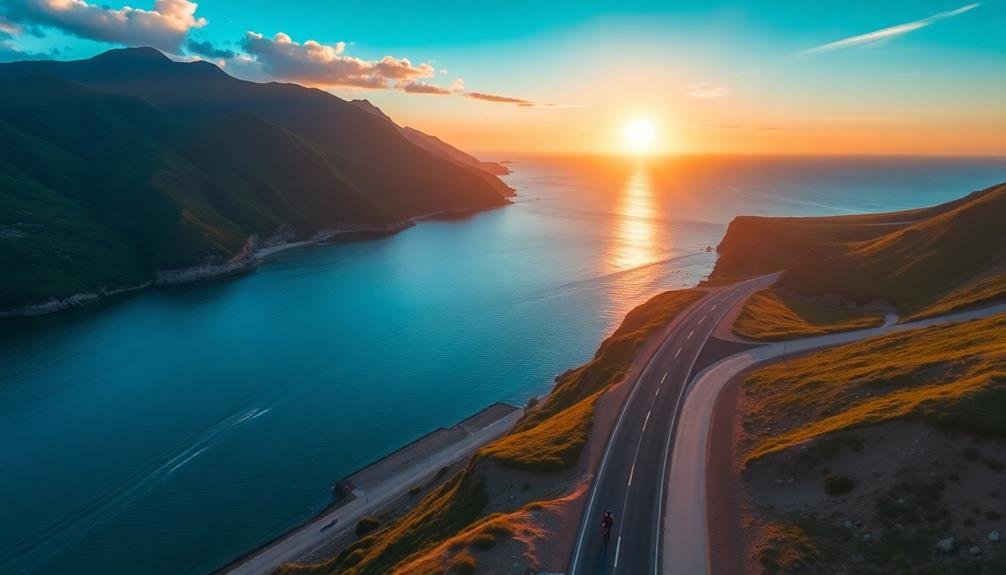
Along with capturing the athletes' performances, triathlon photography offers a unique opportunity to showcase the event's stunning backdrop. You'll find that aerial shots can be particularly effective in highlighting the landscape's beauty while also providing context for the race.
Consider these techniques to enhance your landscape photography during triathlons:
- Use drones to capture sweeping aerial views
- Incorporate natural landmarks into your composition
- Highlight the contrast between athletes and their surroundings
- Capture the changing light conditions throughout the event
- Experiment with wide-angle lenses for panoramic shots
As you frame your shots, look for ways to juxtapose the athletes against the landscape. This can create visually striking images that tell a compelling story about the race and its location.
You'll want to pay attention to the time of day, as golden hour lighting can transform an ordinary scene into something extraordinary.
Don't forget to scout the course beforehand to identify potential vantage points that showcase both the athletes and the scenery.
Ethical Considerations in Drone Usage

When it comes to drone usage in triathlon photography, ethical considerations must be at the forefront of your mind. You're responsible for operating your drone safely and respectfully, ensuring you don't interfere with the event or compromise athletes' privacy.
First, familiarize yourself with local regulations and obtain necessary permits. Respect no-fly zones and maintain a safe distance from participants, spectators, and infrastructure. Always keep your drone within visual line of sight and avoid flying over crowds.
Prioritize privacy by avoiding close-up shots of individuals without consent. Focus on capturing the overall event atmosphere rather than singling out specific athletes.
Be mindful of noise pollution; your drone shouldn't disrupt the race or disturb wildlife in the area.
Consider the environmental impact of your flights. Avoid disturbing natural habitats and wildlife, especially in sensitive ecosystems. Use your drone responsibly to showcase the beauty of the landscape without causing harm.
Lastly, be transparent about your drone usage. Inform event organizers and cooperate with their guidelines.
Post-Processing Aerial Triathlon Images
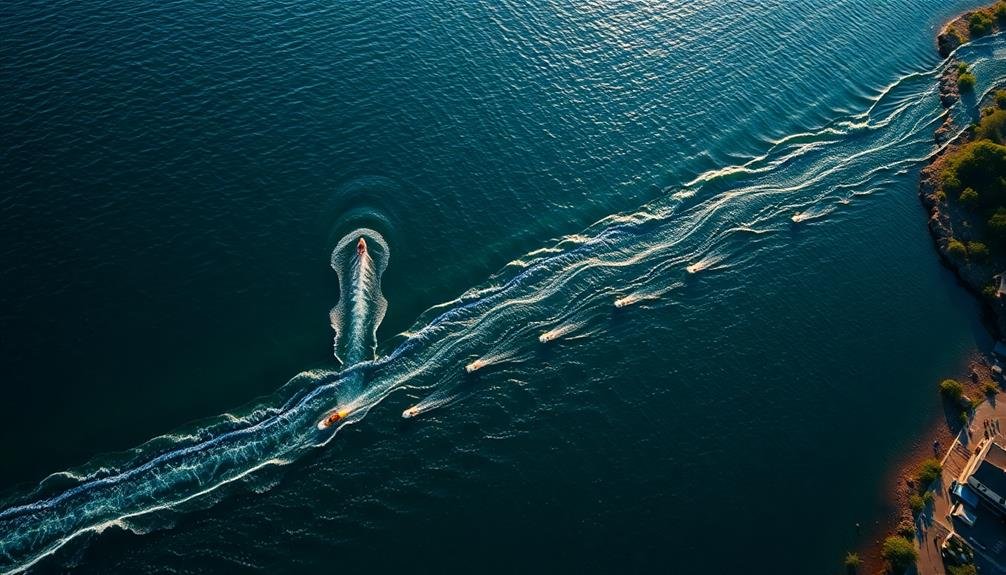
After capturing aerial triathlon images, you'll need to focus on post-processing to make them truly stand out.
Start by enhancing the colors and contrast to bring out the vibrancy of the event and highlight the athletes' efforts.
Don't forget to crop your images for ideal composition, emphasizing the most dynamic elements and removing any distracting elements from the frame.
Enhancing Colors and Contrast
Post-processing magic can transform your aerial triathlon images from good to stunning. When enhancing colors and contrast in your aerial shots, you'll want to strike a balance between vibrancy and realism.
Start by adjusting the overall exposure to guarantee proper brightness. Then, fine-tune the highlights and shadows to bring out details in both bright and dark areas.
To make your triathlon photos pop, focus on these key elements:
- Boost saturation slightly to emphasize the blue water and green landscapes
- Increase vibrance to enhance skin tones and colorful triathlon gear
- Adjust white balance to correct any color casts from atmospheric conditions
- Use selective color adjustments to make certain elements stand out
- Apply targeted contrast to create depth and separation between subjects
Don't forget to sharpen your images to compensate for any softness caused by aerial photography.
Use a subtle vignette to draw the viewer's eye to the center of the frame, where the action is typically happening.
Cropping for Optimal Composition
Cropping your aerial triathlon images can dramatically improve their composition and impact. When working with aerial shots, you'll often capture more than necessary, so cropping becomes essential for focusing on the most compelling elements.
Start by identifying the main subject of your image, whether it's a group of swimmers, cyclists on a winding road, or runners crossing a finish line.
Consider using the rule of thirds to guide your cropping decisions. Place key elements along the imaginary grid lines or at their intersections to create a more balanced and visually appealing composition.
Don't be afraid to crop tightly, especially when highlighting individual athletes or small groups. This can create a sense of intimacy and drama, even from a bird's-eye view.
Pay attention to leading lines in your aerial shots, such as roads, shorelines, or race course markers. Crop to emphasize these lines, guiding the viewer's eye through the image.
When cropping, also consider the aspect ratio that best suits your image and its intended use. Square crops can work well for social media, while wider panoramic crops can capture the expansive nature of the triathlon course.
Storytelling Through Bird's Eye Views
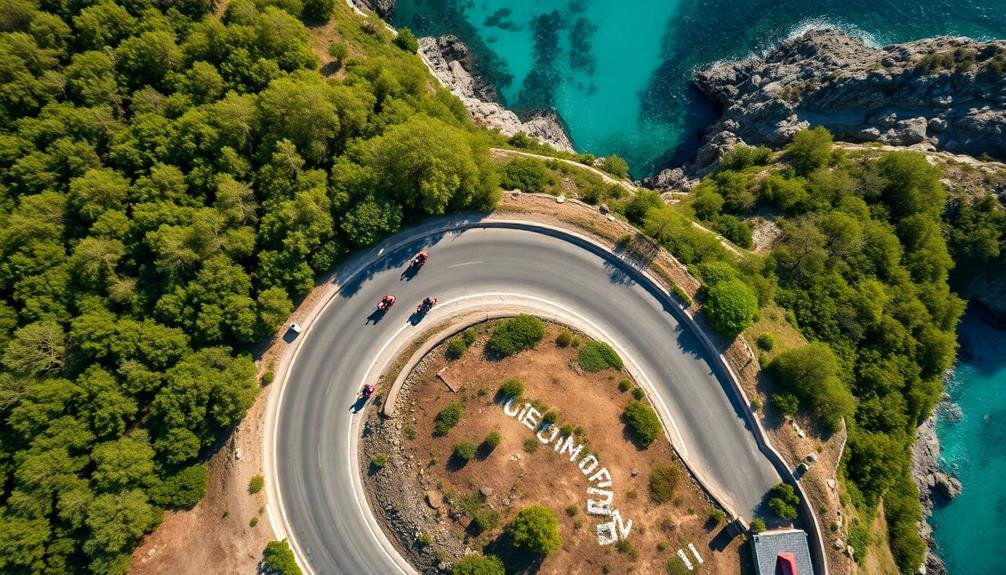
Bird's eye views offer a unique perspective in triathlon photography, allowing you to capture the entire event's scope and drama. From above, you'll showcase the race's layout, athlete positioning, and environmental context in a single frame. This vantage point helps you tell a compelling story of the triathlon's progression and intensity.
To maximize your bird's eye shots, consider these key elements:
- Timing: Capture shifts and key race moments
- Composition: Use natural lines and patterns to guide the viewer's eye
- Lighting: Take advantage of early morning or late afternoon sunlight
- Contrast: Highlight the difference between athletes and their surroundings
- Scale: Include recognizable landmarks to provide context
You'll need to plan ahead for these shots. Secure necessary permissions and scout locations that offer elevated viewpoints. Drones can be an excellent tool, but be sure to comply with local regulations.
When shooting from above, you'll want to use a wide-angle lens to encompass the expansive scene. Adjust your camera settings to account for the distance and potential movement. With practice, you'll master the art of storytelling through bird's eye views, creating engaging images that showcase the triathlon's energy and scale.
Technical Challenges of Triathlon Coverage
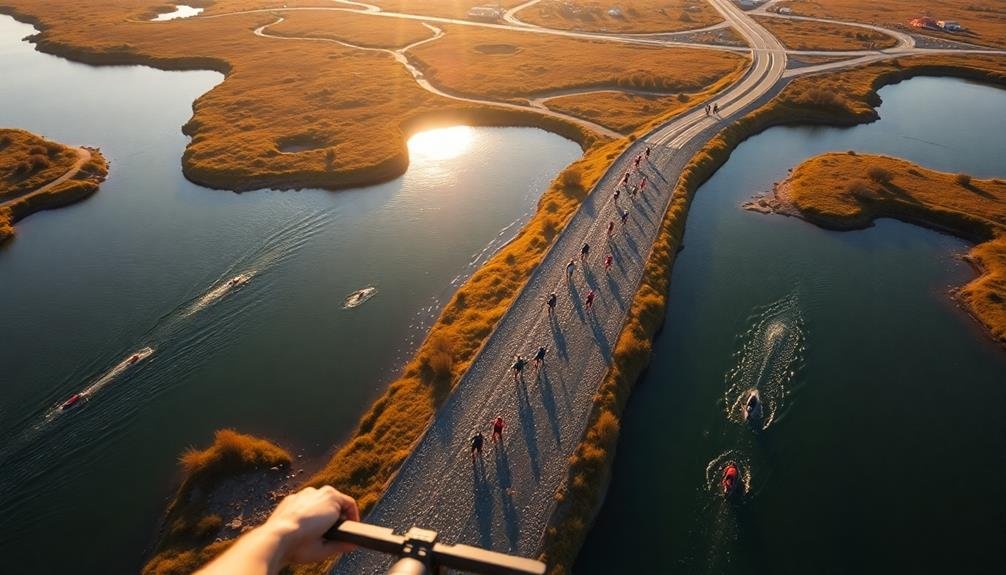
You'll face unique technical hurdles when photographing triathlons due to their multisport nature.
Capturing swimming, cycling, and running requires quick adaptations to different settings and lenses.
You'll also need to contend with varying weather and light conditions as events often span several hours, from dawn to midday.
Capturing Three Diverse Sports
Throughout a triathlon event, photographers face unique technical challenges as they attempt to capture three distinct sports in rapid succession.
You'll need to adjust your equipment and techniques quickly to capture the essence of swimming, cycling, and running.
For the swim portion, you'll likely use a longer lens to capture athletes in the water from a distance.
As the race shifts to cycling, you'll want to be ready with a faster shutter speed to freeze the action.
Finally, for the run, you might opt for a wider lens to capture the athletes against the backdrop of cheering spectators.
To successfully photograph all three disciplines, consider these key points:
- Use weather-sealed equipment to protect against water and sweat
- Prepare multiple camera bodies with different lenses for quick changes
- Master panning techniques for dynamic cycling shots
- Anticipate key moments, like shifts between sports
- Utilize burst mode to capture split-second expressions and movements
Weather and Light Conditions
Triathlon photographers must also contend with ever-changing weather and light conditions. You'll face unique challenges as the event progresses from dawn to midday, often spanning several hours.
Early morning swims may require you to adjust for low light and potential glare off the water's surface. As the sun rises, you'll need to quickly adapt your camera settings to capture cyclists in varying light intensities.
During the run, harsh midday sun can create unflattering shadows and high contrast. You'll want to position yourself strategically to avoid backlighting and use fill flash when necessary.
Overcast days present their own challenges, with flat lighting that can make images appear dull. In these conditions, you'll need to focus on composition and capturing emotion to create compelling shots.
Rain or extreme heat can add another layer of complexity. You'll need to protect your gear while still getting the shot.
Consider using weather-sealed equipment and have a plan for quick cover. Remember, dramatic weather can also lead to stunning, atmospheric images if you're prepared to seize the opportunity.
Athlete Perspectives on Aerial Photography
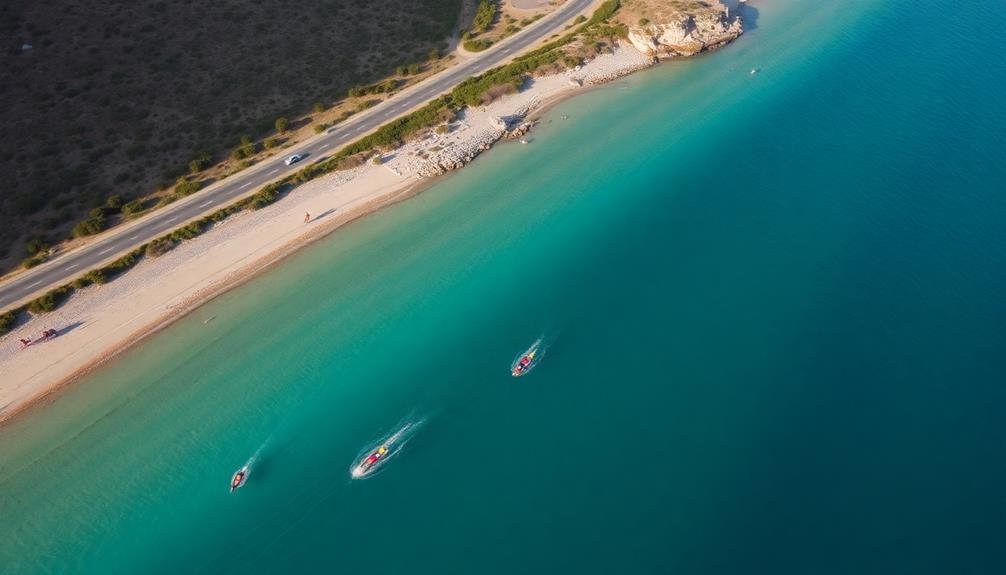
Soaring drones and hovering helicopters have revolutionized triathlon photography, capturing breathtaking aerial shots that athletes both love and loathe.
You'll find a mix of opinions among competitors, with some embracing the bird's-eye views while others express concerns about privacy and distraction.
Many triathletes appreciate aerial photography for its ability to:
- Showcase the event's scale and beauty
- Highlight their achievements in a unique way
- Provide a fresh perspective on familiar courses
- Capture group dynamics during mass starts
- Create stunning promotional material for future races
However, you'll also hear valid concerns from athletes.
Some worry about drones interfering with their focus or potentially causing accidents.
Others feel uncomfortable with the constant surveillance, especially during vulnerable moments like clothing changes in changeover areas.
There's also the question of image rights and how aerial photos might be used without an athlete's consent.
As an athlete, you'll need to weigh these pros and cons.
While aerial photography can elevate the sport's visibility and your personal memories, it's crucial to advocate for clear guidelines that respect your privacy and safety during competitions.
Safety Protocols for Drone Operations
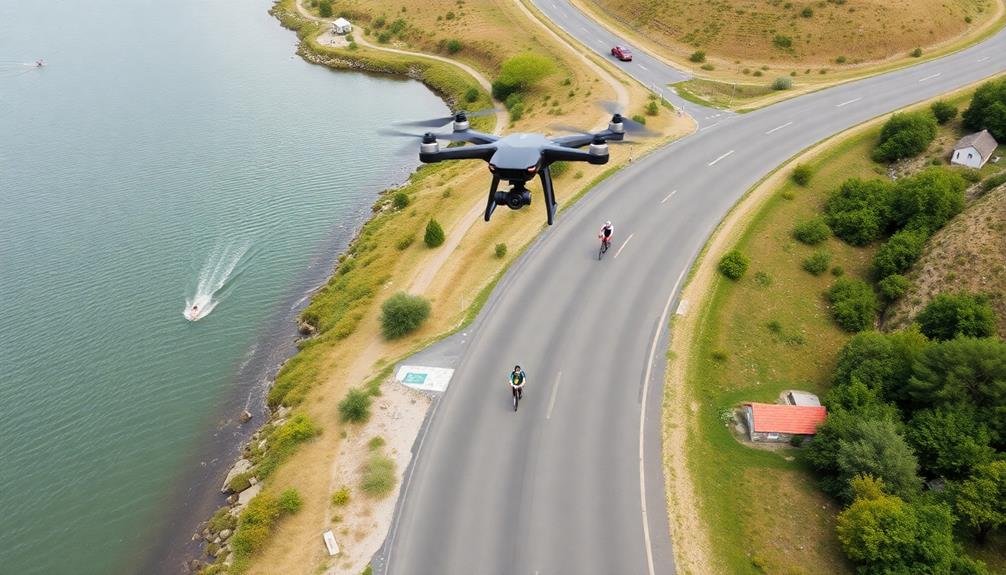
With aerial photography becoming increasingly prevalent in triathlons, organizers and photographers must adhere to strict safety protocols for drone operations. You'll need to obtain proper licensing and certifications before flying a drone at any event. Familiarize yourself with local regulations and airspace restrictions, as these can vary by location.
During the event, maintain a safe distance from athletes, spectators, and infrastructure. You should never fly directly over people or interfere with the race. Keep your drone within visual line of sight at all times and be prepared to land immediately if necessary. It's essential to have a designated takeoff and landing area away from crowds.
Monitor weather conditions closely, as wind and rain can affect drone performance. Always use fully charged batteries and carry spares. Implement a system of communication with event staff to coordinate your flights and avoid potential conflicts with other aerial operations.
Lastly, respect privacy concerns by focusing on capturing the overall event rather than zooming in on individual athletes or spectators. By following these protocols, you'll guarantee a safe and successful aerial photography experience at triathlons.
Marketing Potential of Aerial Shots
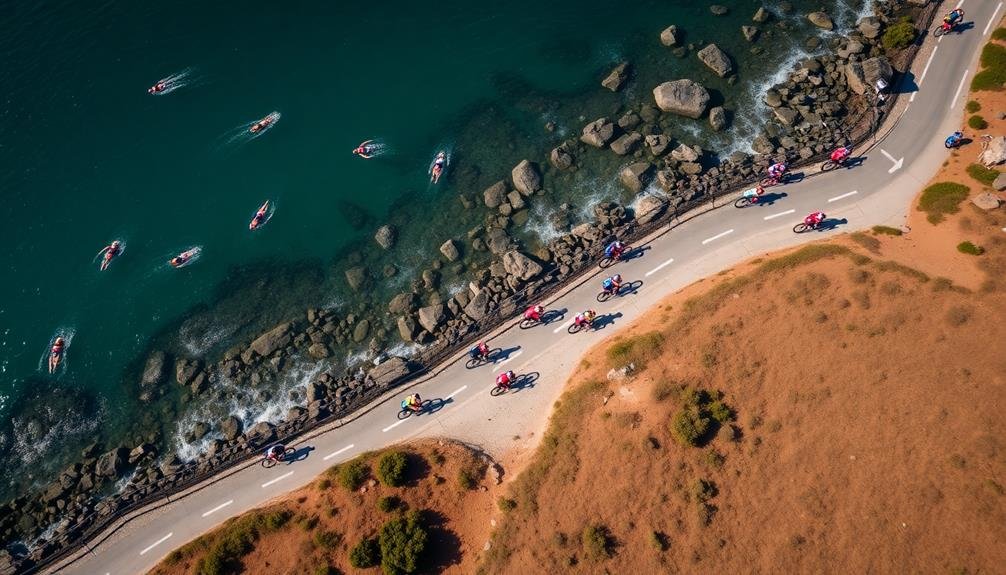
Aerial shots captured during triathlons offer unparalleled marketing potential for event organizers and sponsors alike.
You'll find that these engaging images and videos can elevate your event's visibility and attract more participants, spectators, and sponsors. By showcasing the stunning landscapes, challenging courses, and the sheer scale of the competition, you're creating a powerful visual narrative that resonates with your target audience.
Consider the following marketing opportunities that aerial photography provides:
- Social media content that generates buzz and engagement
- Eye-catching promotional materials for future events
- Compelling footage for race highlight reels and documentaries
- Unique perspectives for sponsorship placement and visibility
- Showcase of the host city or region's attractions
You can leverage these aerial shots to create a lasting impression on athletes, sponsors, and the wider public.
They'll help you tell the story of your event in a way that ground-level photography simply can't match. By incorporating drone footage into your marketing strategy, you're not just promoting a race; you're selling an experience.
This approach can greatly boost your event's profile and attract a broader audience, ultimately leading to increased participation and sponsorship opportunities in future triathlons.
Frequently Asked Questions
How Much Does Professional Triathlon Aerial Photography Equipment Typically Cost?
You'll find professional triathlon aerial photography equipment costs vary widely. High-end drones can range from $1,000 to $20,000, while cameras and lenses may add another $5,000 to $15,000. Don't forget accessories and software expenses too.
Are There Specific Weather Conditions That Limit Aerial Triathlon Photography?
You'll face limitations with aerial triathlon photography in strong winds, heavy rain, or fog. These conditions can affect drone stability, visibility, and image quality. Low temperatures may also impact battery life, reducing your flight time.
What Licensing or Certifications Are Required for Commercial Triathlon Drone Photography?
You'll need a remote pilot certificate from the FAA to fly drones commercially. It's crucial to obtain Part 107 certification, liability insurance, and any local permits. Don't forget to register your drone and follow airspace regulations.
How Do Aerial Photographers Coordinate With Event Organizers and Local Authorities?
You'll need to contact event organizers early to obtain permissions. Work closely with local authorities for flight clearances. Coordinate your flight plan, respect no-fly zones, and follow safety protocols. Always prioritize athlete and spectator safety.
Can Aerial Triathlon Photography Be Used for Performance Analysis and Coaching?
You can definitely use aerial triathlon photography for performance analysis and coaching. It'll give you a unique perspective on athletes' movements, shifts, and race strategies. You'll spot patterns and areas for improvement that aren't visible from ground level.
In Summary
You've now got the tools to elevate your triathlon photography game. With drones, you'll capture stunning aerial views that showcase athletes and landscapes alike. Remember to scout locations, time your shots perfectly, and prioritize safety. As you master these techniques, you'll create unique perspectives that athletes and spectators will love. So grab your gear, get out there, and start shooting. You're ready to bring triathlon photography to new heights!

As educators and advocates for responsible drone use, we’re committed to sharing our knowledge and expertise with aspiring aerial photographers.




Leave a Reply